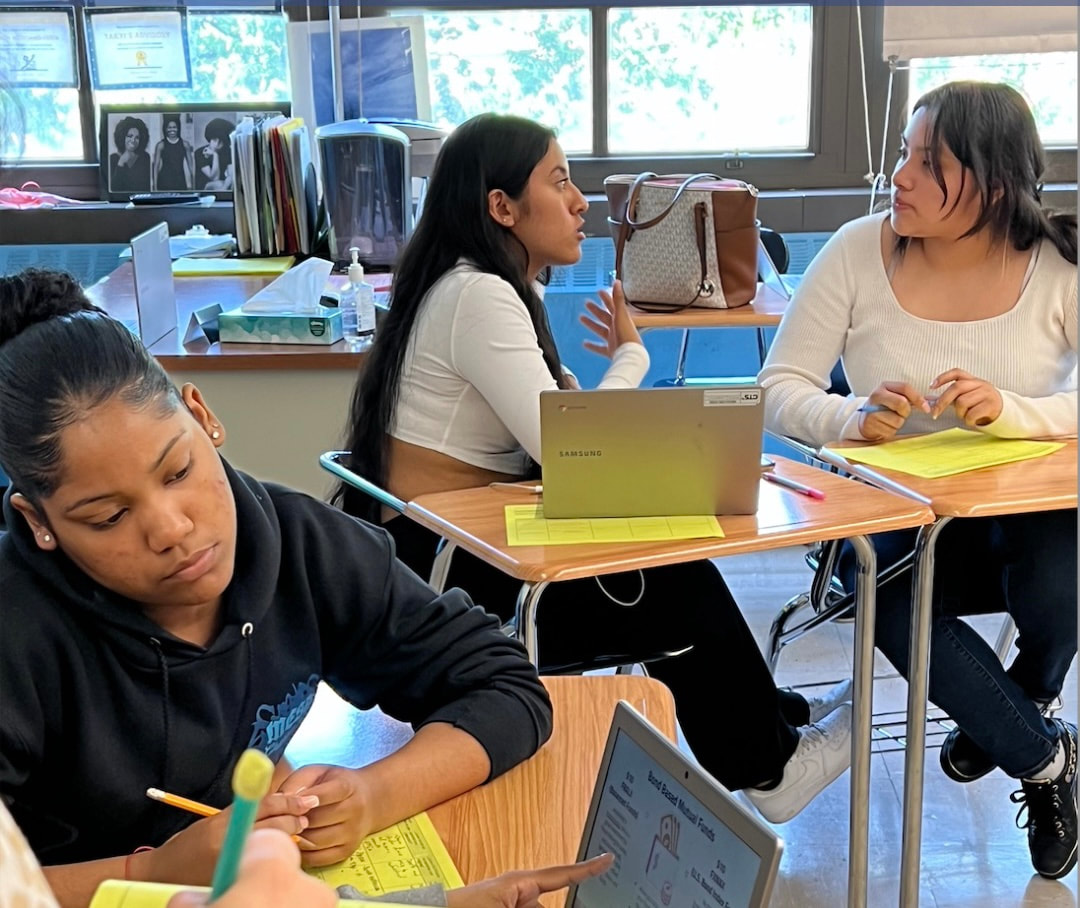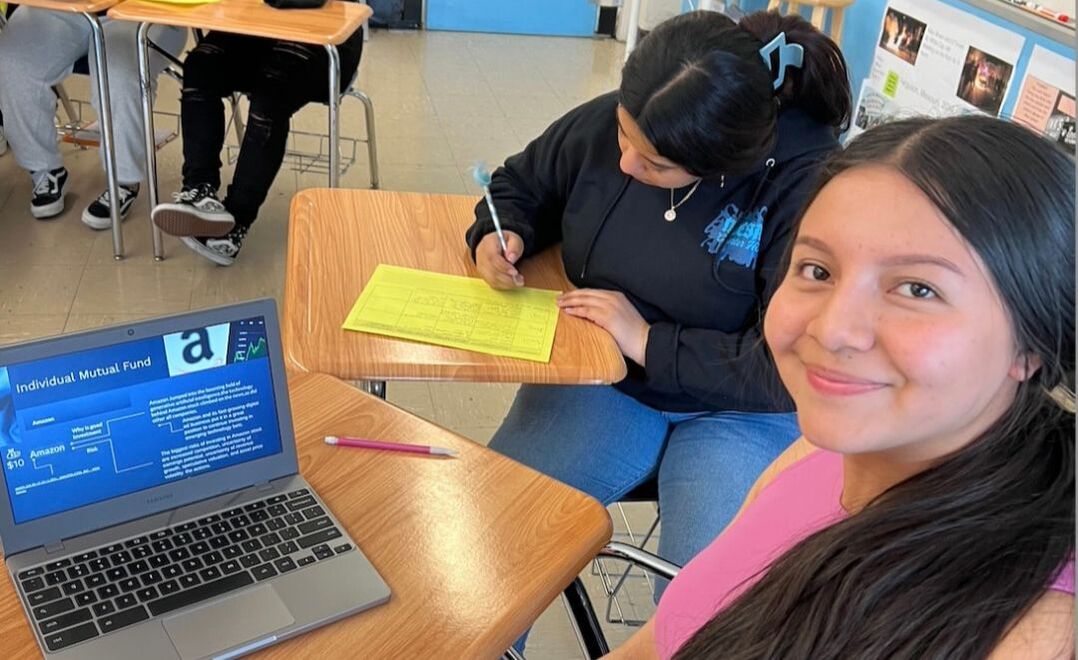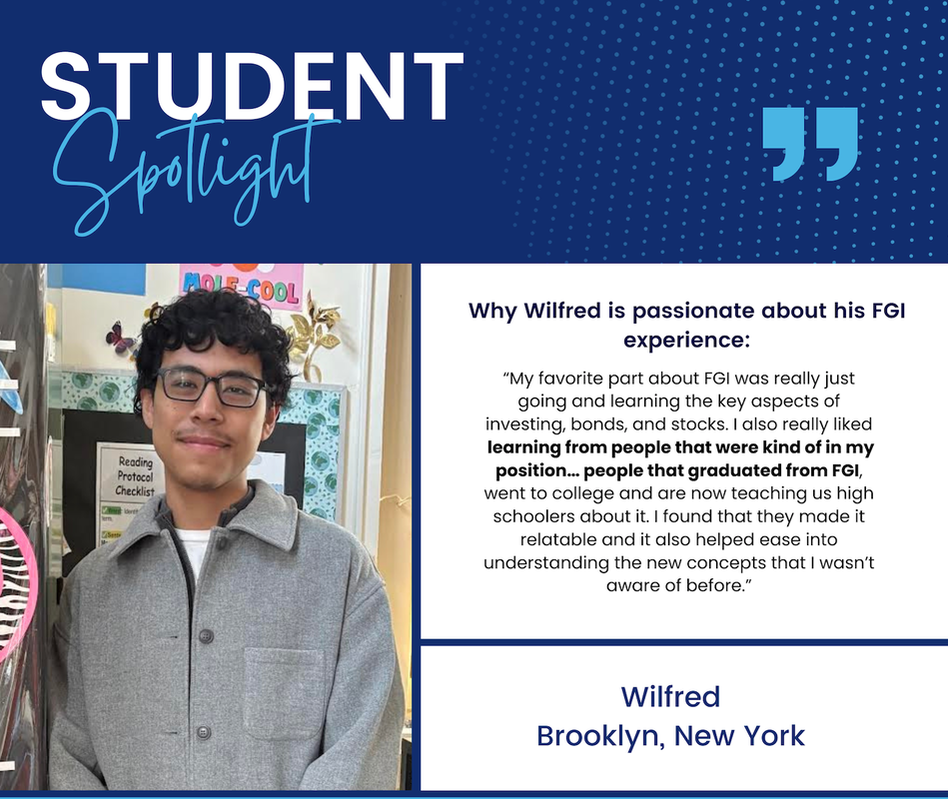Elizabeth “Lizzy” Takyi is an inspirational teacher at MESA Charter School in Brooklyn, New York. While teaching a 12th-grade course combining government and economics, Takyi worked with James Willett, the school's Assistant Principal, to incorporate FGI’s curriculum into her classroom. Over the course of two semesters, students of all English-language and learning levels achieved important skills and knowledge to invest actively in their futures. In the interview below, Lizzy tells a story enumerating the incredible successes, “productive struggles”, and empowering changes that allowed her students to flourish in her New York classroom.
Could you provide some context for how you discovered FGI and why you chose to bring it to your students?
I started at MESA in 2021 teaching a course that dedicates two trimesters to government and one to economics. The curriculum I had for economics didn’t sustain an entire trimester, so I wanted to expand it. The Assistant Principal of our school, James Willett, connected me to FGI, then I worked to incorporate the scope and sequence of the FGI materials into our course curriculum. It took hold quickly, and I worked with students to build their motivation to invest. We definitely gained momentum throughout the trimester. Students were engaged in the lessons and excited about the money they would be granted upon successful completion of the program. We repeated the program this spring and it was a success.You mentioned that many successes emanated from your classroom, could you describe some of those successes?One major thing we did was we adapted the FGI curriculum for students whose first language is not English. Many students’ first language is Spanish, and we needed to make sure the curriculum was accessible to them too, so we translated the worksheets and lessons into Spanish. To make sure all students were fully understanding the material, we also made sure to adapt to different learning levels and learning styles.
What were some highlights of the program?
We had a lot of what I call productive struggle. Some of the topics we covered were dense and abstract for kids that had not been exposed to this type of material before, and it was difficult at times to break them down and make sure they understood. When it came time for students to do research for the capstone project, evaluate different online sources, look into different stocks, and build presentations, it was unlike any research they had ever done. To understand this type of research, I worked together with them to break it down into pieces. Finance as a language is not easy for most people to grasp, especially in a social studies-based course, so there was a huge learning curve. The students were able to adapt to the capstone project, and they put in a ton of extra effort to make that happen.Another highlight is that I was able to see a new side of my students: they were so excited to learn about personal finance. They would go home and bring the conversation back to their families asking to open a bank account or invest in stocks. They understood that they don’t need much to open a bank account. Students got really into building a life outside the classroom; they began thinking about their futures and things like subsidized versus unsubsidized student loans, how to invest in themselves, and how to build a skill set for their future selves headed off to college. It was a perfect time to have this right before starting college life.Ms. Elizabeth “Lizzy” Takyi is an extremely talented teacher at MESA Charter School in Brooklyn, New York. Teaching a combined government and economics course to 12th graders, Takyi worked with James Willett, the school's Assistant Principal, to incorporate FGI’s curriculum into her classroom. Over the course of two semesters, students of all language and learning levels have gained the skills and knowledge to invest actively in their futures. In the interview below, Lizzy tells a story of successes, “productive struggles”, modifications, and empowerment that allowed her students to flourish in her New York classroom.
Could you provide some context for how you discovered FGI and why you chose to bring it to your students?
I started at MESA in 2021 teaching a course that dedicates two trimesters to government and one to economics. The curriculum I had for economics didn’t sustain an entire trimester, so I wanted to expand it. The Assistant Principal of our school, James Willett, connected me to FGI, then I worked to incorporate the scope and sequence of the FGI materials into our course curriculum. It took hold quickly, and I worked with students to build their motivation to invest. We definitely gained momentum throughout the trimester and students were engaged in the lessons and excited about the money they would be granted upon successfully completing the program. We repeated the program this spring and it was a success.
You mentioned that many successes emanated from your classroom, could you describe some of those successes?
One major thing we did was we adapted the FGI curriculum for students whose first language is not English. Many students’ first language is Spanish, and we needed to make sure the curriculum was accessible to them too, so we translated the worksheets and lessons into Spanish. To make sure all students were fully understanding the material, we also made sure to adapt to different learning levels and learning styles.
What were some highlights of the program?
We had a lot of what I call productive struggle. Some of the topics we covered were dense and abstract for kids that had not been exposed to this type of material before, and it was difficult at times to break them down and make sure they understood. When it came time for students to do research for the capstone project, evaluate different online sources, look into different stocks, and build presentations, it was unlike any research they had ever done. To understand this type of research I worked together with them to break it down into pieces. Finance as a language is not easy for most people to grasp, especially in a social studies-based course, so there was a huge learning curve. The students were able to adapt to the capstone project, and they put in a ton of extra effort to make that happen.Another highlight is that I was able to see a new side of my students: they were so excited to learn about personal finance. They would go home and bring the conversation back to their families asking to open a bank account or invest in stocks. They understood that they don’t need much to open a bank account. Students got really into building a life outside the classroom; they began thinking about their futures and things like subsidized versus unsubsidized student loans, how to invest in themselves, and how to build a skill set for their future selves headed off to college. It was a perfect time to have this right before starting college life.



.png)
.png)

